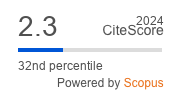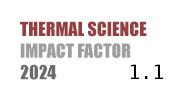THERMAL SCIENCE
International Scientific Journal
ANALYZING THERMAL RUNAWAY BEHAVIOR OF LITHIUM-ION BATTERIES IN FULL-SIZE ELECTRIC VEHICLES A COMPARATIVE STUDY OF EXTINGUISHING AGENTS
ABSTRACT
Lithium-ion batteries are commonly used in electric vehicles and other electrical devices. However, their thermal behavior can pose safety challenges. Thermal abuse can lead to fires, known as thermal runaway, with high heat release rates and the emission of toxic gases. This paper discusses thermal runaway in lithium-ion batteries during electrical vehicles production, emphasizing the need for early fire intervention. Five experiments were conducted to validate lithium-ion batteries thermal runaway and assess organic and inorganic-based extinguishing agents. The inorganic quenching agent could rapidly cool the lithium-ion batteries surface temperature to 75°C within just 50 seconds, delaying the onset of thermal runaway. The organic-based extinguishing agent failed to extinguish the lithium-ion batteries fire even after three interventions in the thermal abuse test. However, the inorganic-based extinguishing agent successfully extinguished lithium-ion batteries fires that had entered thermal runaway with only one portable extinguisher. Fire blankets can also be effectively used in electric vehicles fires. Unlike organic extinguishing agents, a single tube of the inorganic quenching agent is sufficient for thermal runaway.
KEYWORDS
PAPER SUBMITTED: 2024-11-10
PAPER REVISED: 2025-04-23
PAPER ACCEPTED: 2025-04-28
PUBLISHED ONLINE: 2025-09-26
THERMAL SCIENCE YEAR
2025, VOLUME
29, ISSUE
Issue 4, PAGES [2977 - 2988]
- Lu, L., et al., A Review on the Key Issues for Lithium-Ion Battery Management in Electric Vehicles, Journal of Power Sources, 226, (2013), Mar., pp. 272-288
- Wang, H., et al., Experimental Study on the Cell-Jet Temperatures of Abused Prismatic Ni-Rich Automotive Batteries under Medium and High States of Charge, Applied Thermal Engineering, 202, (2022), 117859
- Chen, J., et al., Designing an Intrinsically Safe Organic Electrolyte for Rechargeable Batteries, Energy Storage Materials, 31 (2020), Oct., pp. 382-400
- Park, S.-Y., et al., Observation and Modeling of the Thermal Runaway of High-Capacity Pouch Cells due to an Internal Short Induced by an Indenter, Journal of Energy Storage, 72 (2023), 108518
- Duan, J., et al., Building Safe Lithium-Ion Batteries for Electric Vehicles: A review, Electrochemical Energy Reviews, 3 (2020), 1, pp. 1-42
- Golubkov, A. W., et al., Thermal Runaway of Commercial 18650 Li-Ion Batteries with LFP and NCA Cathodes - Impact of State of Charge and Overcharge, RSC Adv., 70 (2015), 5, pp. 57171-57186
- Wang, E., et al., Safety Assessment of Polyolefin and Nonwoven Separators Used in Lithium-Ion Batteries, Journal of Power Sources, 461 (2020), 228148
- Ghiji, M., et al., A Review of Lithium-Ion Battery Fire Suppression, Energies, 13 (2020), 19, 5117
- Jin, Y., et al., Explosion Hazards Study of Grid-Scale Lithium-Ion Battery Energy Storage Station, Journal of Energy Storage, 42 (2021), 102987
- Fan, R., et al., Numerical Analysis on the Combustion Characteristic of Lithium-Ion Battery Vent Gases and the Suppression Effect, Fuel, 330 (2022), 125450
- Said, A. O., Stoliarov, S. I., Analysis of Effectiveness of Suppression of Lithium Ion Battery Fires with a Clean Agent, Fire Safety Journal, 121 (2021), 103296
- Yu, D., et al., Fire extinguishing test of lithium-ion battery case in electric bus, Proceedings, 9th International Conference on Fire Science and Fire Protection Engineering (ICFSFPE), Chengdu, China, 2019, pp. 1-5
- Zhang, L., et al., Experimental Study on the Synergistic Effect of Gas Extinguishing Agents and Water Mist on Suppressing Lithium-Ion Battery Fires, Journal of Energy Storage, 32 (2020), 101801
- Liu, Y., et al., Experimental Study on a Novel Safety Strategy of Lithium-Ion Battery Integrating Fire Suppression and Rapid Cooling, Journal of Energy Storage, 28 (2020), 101185
- Sun, H., et al., Experimental Study on Suppressing Thermal Runaway Propagation of Lithium-Ion Batteries in Confined Space by Various Fire Extinguishing Agents, Process Safety and Environmental Pro-tection, 167 (2022), Nov., pp. 299-307
- Sun, P., et al., A Review of Battery Fires in Electric Vehicles, Fire Technology, 56 (2020), 6, 1361-1410
- Hassan, M. K., et al., Fire Incidents, Trends, and Risk Mitigation Framework of Electrical Vehicle Cars in Australia, Fire, 6 (2023), 8, 325
- Zhang, G., et al., Study on the Suppression Effect of Cryogenic Cooling on Thermal Runaway of Ternary Lithium-Ion Batteries, Fire, 5 (2022), 6, 182
- Wang, K., et al., Early Warning Method and Fire Extinguishing Technology of Lithium-Ion Battery Thermal Runaway: A Review, Energies, 16 (2023), 7, 2960
- Cai, T., et al., Early Detection for Li-Ion Batteries Thermal Runaway Based on Gas Sensing, ECS Transactions, 89 (2019), 1, 85
- Kethareswaran, V., Moulik, S., Electric Vehicles and the Burning Question: Reasons, Risks, Ramifications and Remedies - An Indian Perspective, Fire Technology, 59 (2023), 6, pp. 2189-2201
- Tran, M.-K., et al., a Review of Lithium-Ion Battery Thermal Runaway Modeling and Diagnosis Approaches, Processes, 10 (2022), 6, 1192
- Kang, S., et al., Full-Scale Fire Testing of Battery Electric Vehicles, Applied Energy, 332 (2023), 120497

